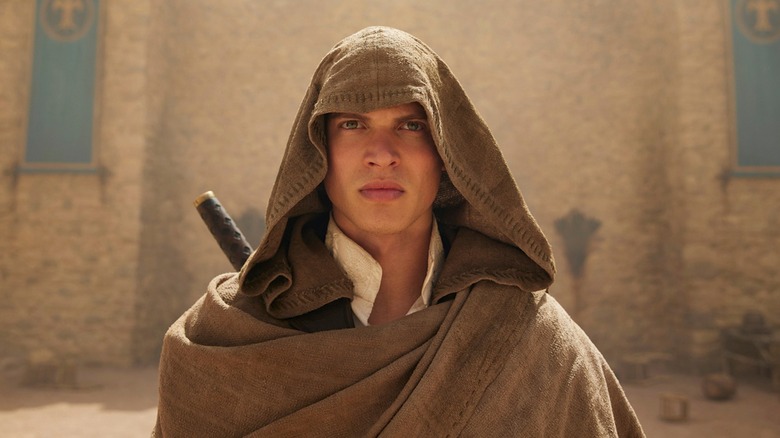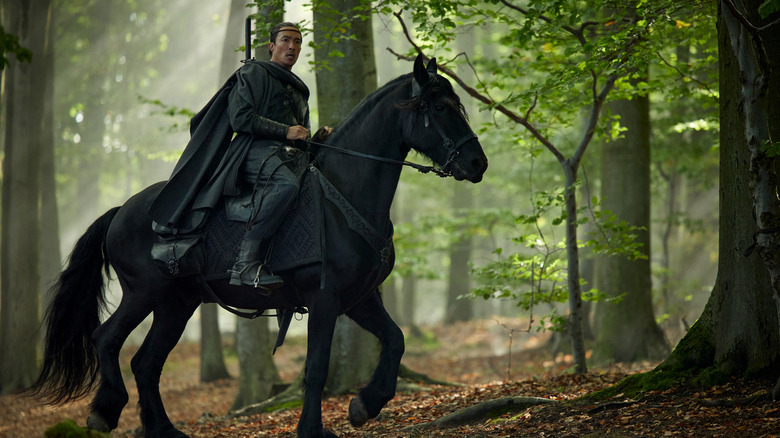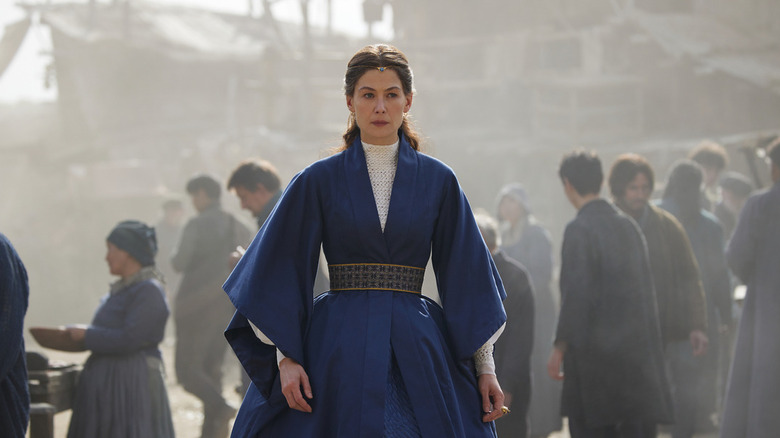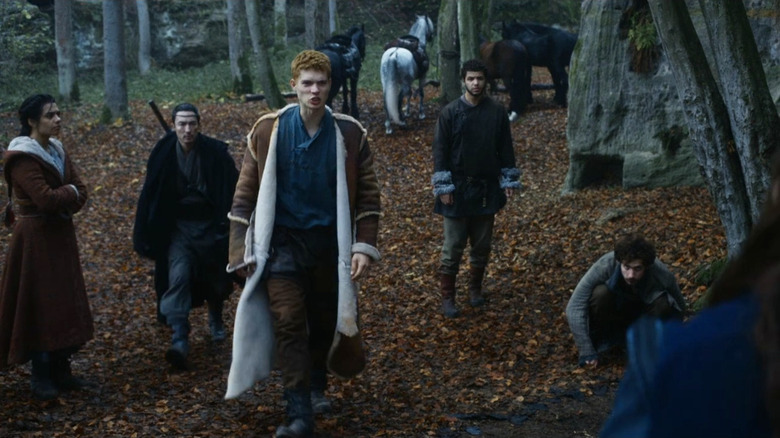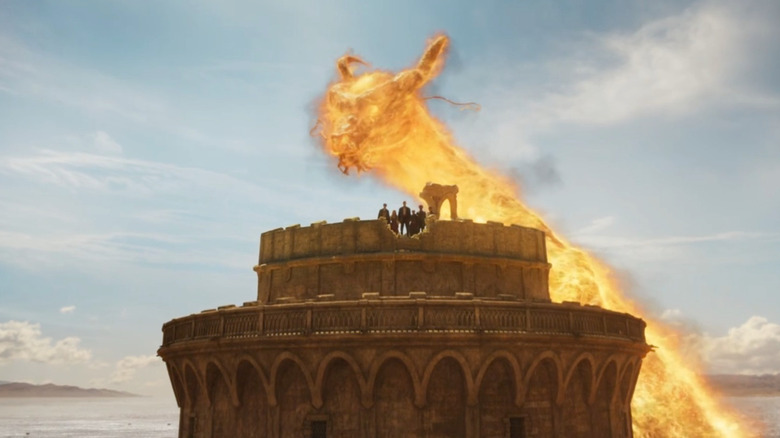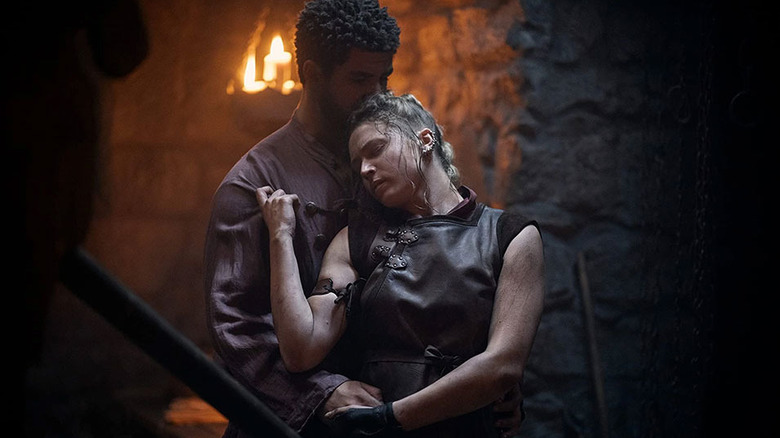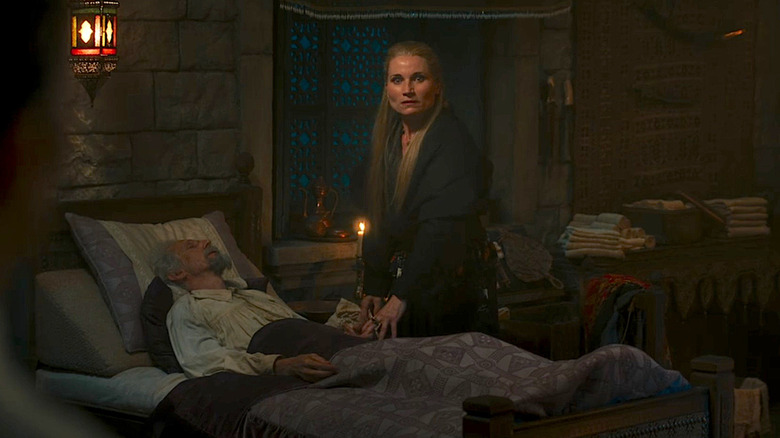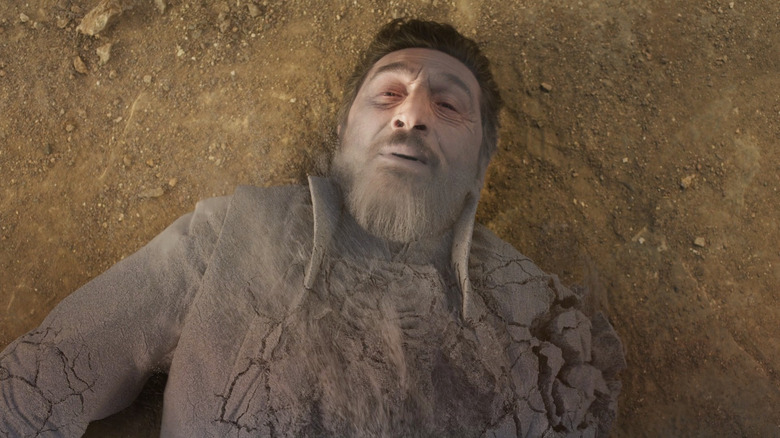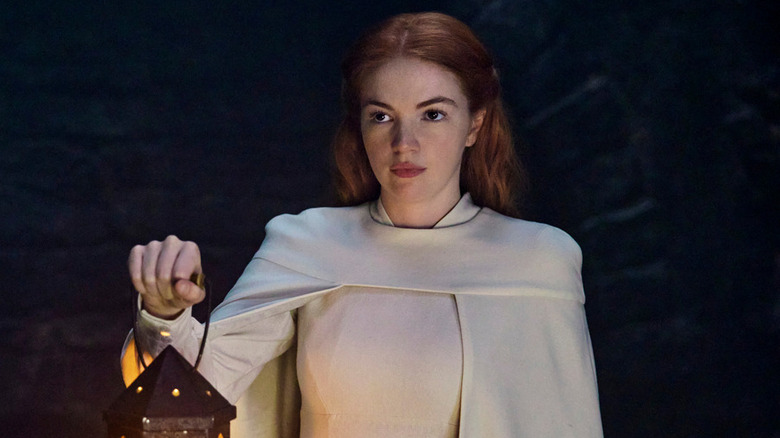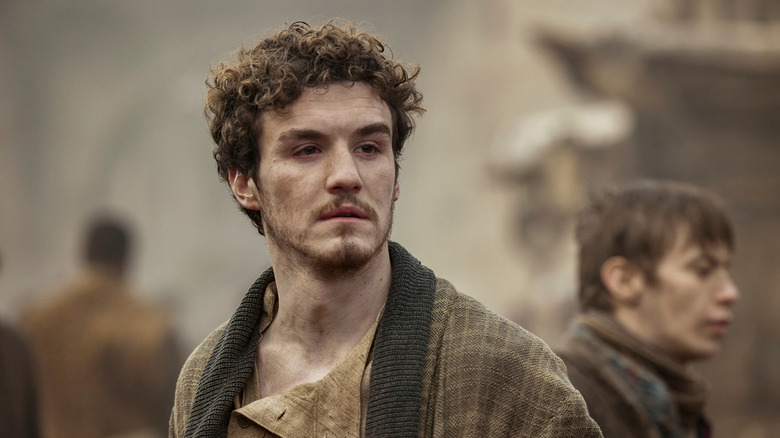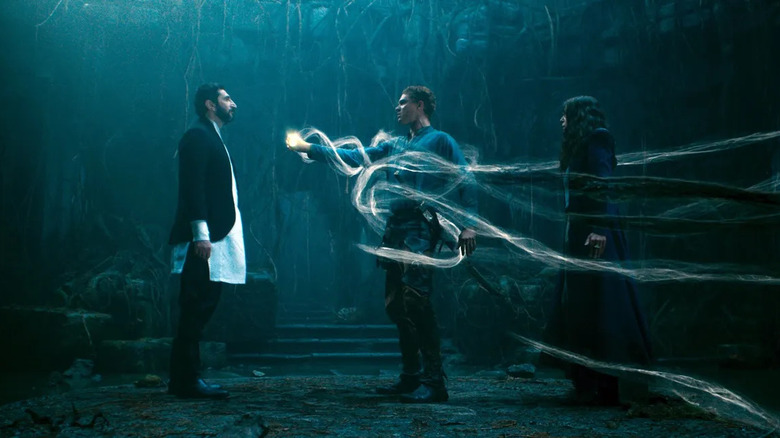The Major Differences Between Amazon Prime's The Wheel Of Time Series And The Books
"The Wheel of Time" has had a wild two-season swing to start its story. Season 1 received a rather middling audience score from fans on Rotten Tomatoes, although Season 2 has so far been much better received. The second installment of the show picked up the pace, moving the story forward and building momentum as it started to work Rand and the rest of the Two River heroes toward the inevitable Last Battle.
However, Season 2 did this while making plenty of changes to the source material. Both seasons consistently tweak, change, and rewrite Robert Jordan's novels to condense the massive 14-book primary story. This is expected in a world with thousands of named characters and dozens of points of view. In a recent interview with Looper, executive producer Mike Weber explained, "You pick your favorites, and you focus on them. That's what Rafe and the writers have done. You zero in on the most dramatic, the most emotional, the most action-oriented points of view, and you tell the story through their eyes, for the most part. That's easier for an audience to engage through."
While effective, this approach does lead to a lot of alterations. Let's take a look at some of the biggest differences — both good and bad — between the first two seasons of Amazon Studios' show and Robert Jordan's correlating source material.
The speed of the story is accelerated
It may not always feel like Amazon's show is moving fast. With so many faces and narrative threads, Season 1 feels particularly slow at times. Nevertheless, the show is actually moving along at a brisk pace. It is trimming off storylines, truncating events, and cutting or combining characters at every turn.
One example is Elyas Machera (Gary Beadle). The wolfbrother is an important part of Perrin's (Marcus Rutherford) journey in the first book as he learns about his lupine connection. In the second book, the heroes are joined by a fella named Hurin, who can literally sniff violence and operate as a tracker of their assault-prone enemies. In Amazon Studios' series, Elyas is absent in Season 1 and replaces Hurin in Season 2, saving time and keeping things moving forward in the process.
The pacing of the story isn't a knock, either. There's no way an on-screen adaptation could accurately include everything in the books. The fact that they're slowly working things into a flowing narrative shows that showrunner Rafe Judkins may be cracking the adaptive code for this particularly massive IP. Perhaps "speed up" isn't even the right word here. In the above-mentioned interview, executive producer Marigo Kehoe specifically clarifies, "It's got its own momentum. It does speed up. It is big." In reference to the Season 2 time jump, "you jump and find them in different places, which gives its own momentum. And [it's] very character-driven, which is wonderful."
Moiraine's doesn't lose her powers
At the end of Season 1, Moiraine (Rosamund Pike) appears to be stilled by Ishamael (Fares Fares), who is one of the strongest members of the Dark One's group of super-powered henchmen called the Forsaken. Ishamael barely skips a beat as he uses the One Power to apparently cut Moiraine off from her otherworldly source of strength.
This leads to a Season 2 story arc for Moiraine that focuses on what she does in the wake of losing her connection to the power source that makes her feel whole. In most cases when someone is stilled they lose the will to live. However, the Aes Sedai knows she must help Rand, and she stays focused on her task. By the end of the season, we see that she wasn't actually stilled. She was just expertly blocked from the One Power in a nearly unnoticeable way — thanks for figuring that out, Lan! She gets her power back, and all is well with the world again.
Except that Moiraine doesn't actually lose her power in the second or third books (which are the primary source material for Season 2). She simply takes more of a back seat to Rand as he steps into his role as the Dragon Reborn. This shift to a minor support character works fine in Jordan's overcrowded world, but in Amazon Studios' series, Pike is arguably the most famous face on set. This may have been a way to keep her front and center.
The number of ta'veren characters changes
As its title implies, Jordan's world centers on the cyclical concept of time as a wheel weaving a "pattern" of threads that collectively make up the entire story. The show has expertly depicted this in its opening sequence, which shows many elements of the story in the form of a loom weaving hundreds of threads into a single weave.
As the Wheel turns, it resets a cycle of history that replays as individuals are rebirthed, appearing in different forms and getting involved in the story in different ways. Most people are swept along by the current of the Wheel, helplessly along for the ride. However, there are a small number of people– the ta'veren – around whom the Wheel weaves the Pattern, adjusting the weave based on their presence and actions. Even one ta'veren is a big deal, but Jordan's books start with three of them in a single town tucked away in the Westlands. We're talking about Perrin, Mat (Barney Harris/Dónal Finn), and, of course, Rand (Josha Stradowski).
In the text, that's it, though. While Egwene (Madeleine Madden) and Nynaeve (Zoë Robins) are important, they aren't ta'veren. In the show, they get an upgrade, as all five Emonds Field youngsters are ta'veren. They are also all considered potential Dragons before Rand is singled out, whereas only the boys are candidates in the books.
A literal dragon shape in the sky?
The end of Season 2 features an epic battle in and around the far western city of Falme. Perched on the edge of the western ocean, this is one of the first places where the Seanchan appear as they begin to invade the continent. This pulls the Season 2 story to Falme, with all of our ta'veren heroes reuniting in the city by the end of Episode 8.
In that final showdown, Rand finally unleashes the One Power, embracing his role as the Dragon Reborn and the savior of the world. He defeats the Forsaken leader Ishamael on top of a tower that overlooks the city. This sets the stage for him to fulfill an ancient prophecy that the Dragon Reborn will be seen in the sky over the city. Moiraine obliges by whipping up a literal light-infused dragon that wraps around the tower and Rand.
It's a fun scene, but there are some major changes from the source material. In the second book, "The Great Hunt," there is a similar showdown that people see in the sky, but it is the reflections of Rand and Ishamael's real fight that flicker in the sky (sort of from another dimension — it's complicated). Moiraine also isn't involved. This is a much more subtle, albeit epic, version of the Dragon-in-the-sky reveal. The depiction of this in the show is a little cheesy, but it does help send a clearer message to fairweather viewers just trying to keep up.
Perrin isn't married, guys...
Perrin isn't married in "The Wheel of Time" — or more specifically, he isn't married when it starts. He does eventually meet an important individual, who we'll leave alone for now, but the wolfbrother-to-be hasn't tied and doesn't tie the knot in the first books.
This is obviously altered in the show. One of the first things we see is Perrin's wife, Laila (Helena Westerman), who is introduced as a moody spouse and a hard-working blacksmith. We get to know her for point-two seconds before Perrin accidentally kills her when fighting a Trolloc. The addition of a wife for Perrin is unexpected and muddles an already complicated story. Sure, it speeds up Perrin's character development, but with so much going on, was that really necessary?
Introducing a female character simply to bump her off and raise the stakes of a male character has been controversial. In an interview with The Hollywood Reporter, showrunner Rafe Judkins confirmed that the move was to accelerate Perrin's story. However, Brandon Sanderson (an advisor on the show who co-authored the last few books of the series) posted a Reddit thread explaining that he disagreed with the move and thought the trauma of killing a spouse was too much. He recommended keeping Perrin single and having him accidentally kill his master to tone it back and avoid what he called an unnecessary pull toward a "Grimdark" tone like "Game of Thrones."
Liandrin doesn't have a son, either
Liandrin (Kate Fleetwood) is a compelling character in Amazon Studios' adaptation. The Aes Sedai of the Red Ajah is a strict, cold-hearted leader who ruthlessly hunts down men who can channel, cutting them off from the One Power and leaving them husks of their former selves. In Season 2, she was revealed to be a member of the Black Ajah, as well, taking her already disturbing story arc and cranking it up to 11.
Most of Liandrin's larger story elements have fallen in line with the books. She is more involved in Season 1 than she was in Book One, but her importance as a Darkfriend and a member of the Black Ajah quickly thrusts her into the spotlight in both the books and the television series as the story progresses.
One area that doesn't line up, though, is her son. In Season 2, we're introduced to a compassionate side of her character when she's shown secretly caring for an elderly man named Aludran. This ends up being her son, indicating that despite her immortal Aes Sedai appearance, she is very old. In the end, the Forsaken Lanfear kills Aludran in front of his mother, pushing her dark streak into overdrive. The entire son storyline is added for the series and appears to be similar to Perrin's wife — a way to build depth for an otherwise plot-driven character. In this case, though, it works better, as the premise is more feasible.
Ishamael doesn't die at Falme
Throughout Season 2, it becomes clear that the Forsaken leader Ishamael may be powerful, but he also longs for death. He confronts Rand at the end of both seasons, but in Season 2, it appears that he is finally released from his living prison. The man literally crumbles to ashes.
This is a deviation from the books. Ishamael and Rand are wounded, but there is more fighting to come between the two. Of course, in a world like Robert Jordan's, resurrection is always a possibility, but the apparently final death of the primary antagonists of the first two seasons is definitely a zag from the books. Perhaps we'll see Fares Fares' character again, although it's anything but certain.
The Ogier Loial, for instance, appeared to die at the end of Season 1, but the series simply showed him healed, alive, and well as soon as Season 2 started. That said, Ishamael's death seemed much more complete, in the physical sense, at least. It's also worth noting that showrunner Rafe Judkins explained in an interview after Season 1 that the Loial fake-out death was prep for potentially unexpected deaths coming down the road — and not just those from the source material.
As Judkins explained, "I wanted people to be a little on their toes, because real deaths are coming for characters that don't die in the books." Ishamael may really be dead, guys — which doesn't line up with the source material at all.
An entire city is removed from Season 1
The city of Caemlyn plays an important role in the first book. The massive city center is second only to Tar Valon in the landscape of the Randland, and a lot of stuff happens there early in the story. Rand meets Loial in Caemlyn. Mat is bedridden by his dagger in Caemlyn. The False Dragon Logain (Álvaro Morte) first shows up in Caemlyn. The heroes start running into murderous Darkfriends around Caemlyn.
Most importantly, it's in Caemlyn that Rand climbs a wall and accidentally tumbles over it into the palace grounds. There, he meets Elayne Trakand (Ceara Coveney), Daughter-Heir of Andor. This introduction is cut from Season 1 entirely, with Elayne showing up in the White Tower in Season 2. She and Rand still haven't met on screen, but trust us, they will.
Caemlyn is a busy area, but it has been completely written out of Amazon's adaptation so far. This change makes sense, though. There are a ton of places in Jordan's world. In the previously-mentioned interview, producer Holger Reibiger also told Looper that the creative team at Amazon Studios had built or re-used between 250 and 300 sets for Season 2 alone. Adding another set as massive as Caemlyn would have been challenging, and bundling those events into other areas of their on-screen world — especially an urban center as similar in feel as Tar Valon — doesn't disrupt things too much.
Mat doesn't stay behind on the way to the Eye of the World
Toward the end of Season 1, Mat Cauthon splits off from his friends, staying behind as the others head into the Ways. The irrevocable move is unexpected and certainly doesn't jive with the source material. It's understandable, though, as Mat actor Barney Harris had to bow out of the production for personal reasons.
Mat's presence was missed in the final episode of the season, but things got even weirder heading into Season 2. With his book-based arc thrown off, the show ends up stuffing Mat (now recast as Dónal Finn) into a cell for several months as the evil Aes Sedai Liandrin's captive. There, he meets Min Farshaw (Kae Alexander) and eventually escapes to link back up with everyone in Falme.
While the turbulence of the Mat storyline thus far is clearly due to a lot of behind-the-scenes concerns, it doesn't change the fact that the character has had a bumpy ride in the larger story so far. He was way off track throughout the first two seasons. Hopefully, blowing the Horn of Valere gets Mat's story back on track again moving into Season 3.
Basically the entire end of Season 1
Season 1 ends with the Emons Field Five, Moiraine, Lan (Daniel Henney), and Loial confronting the Dark One at an important spot called the Eye of the World. This leads to a multi-faceted showdown as the local Shienaran forces — aided by a scrappy group of female channelers — resist an army of Trollocs while Rand and Moiraine head to the Eye of the World to seek out their greatest foe.
In the end, the Trolloc horde is obliterated, but not before Nynaeve and others are partly or completely consumed by the One Power. At the Eye of the World, Rand confronts his enemies solo, and Moiraine is, to all intents and purposes, stilled.
Nearly everything here is altered from the books.
In the source material, all five of the Two Rivers folk go to the Eye of the World. At the Eye, they meet a fascinating character called the "Green Man," who sacrifices himself to help them defeat two Forsaken named Aginor and Balthamel. Rand does battle Ishamael, but he's also the one who defeats the army of Trollocs using the One Power. Moiraine is hurt but not stilled, Loial isn't stabbed, and the Horn of Valere is found at the Eye of the World, not under a throne. The number of changes upset a lot of fans. Fortunately, Season 2 appears to have gotten back on track for the most part. Here's hoping Season 3's changes are all for the better.
